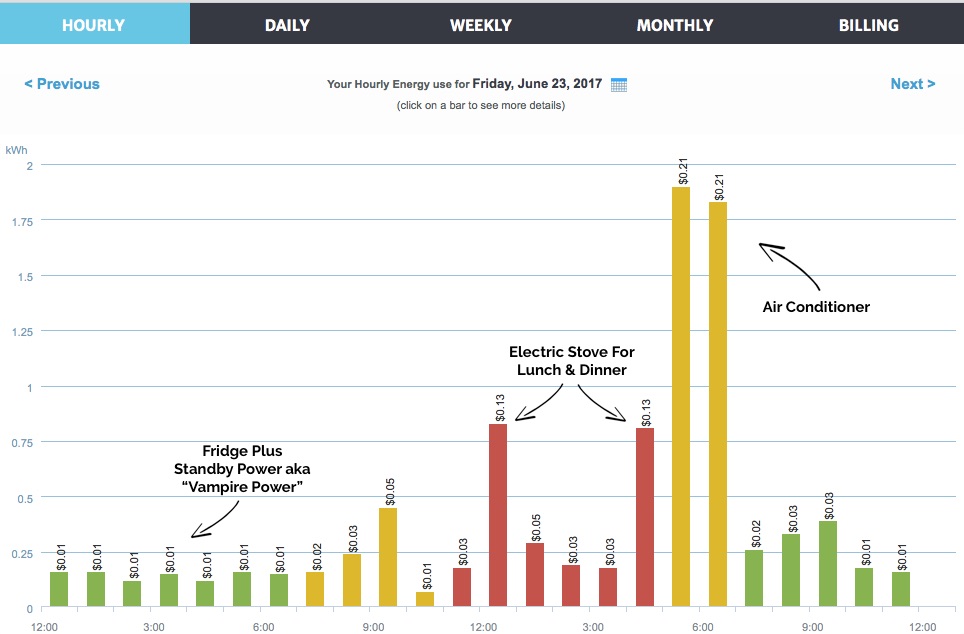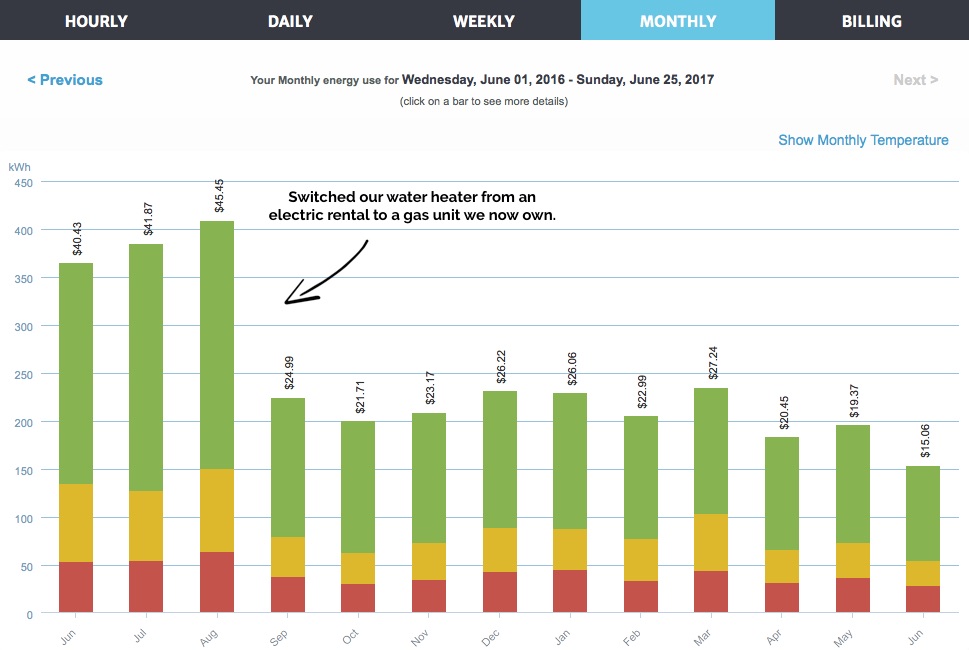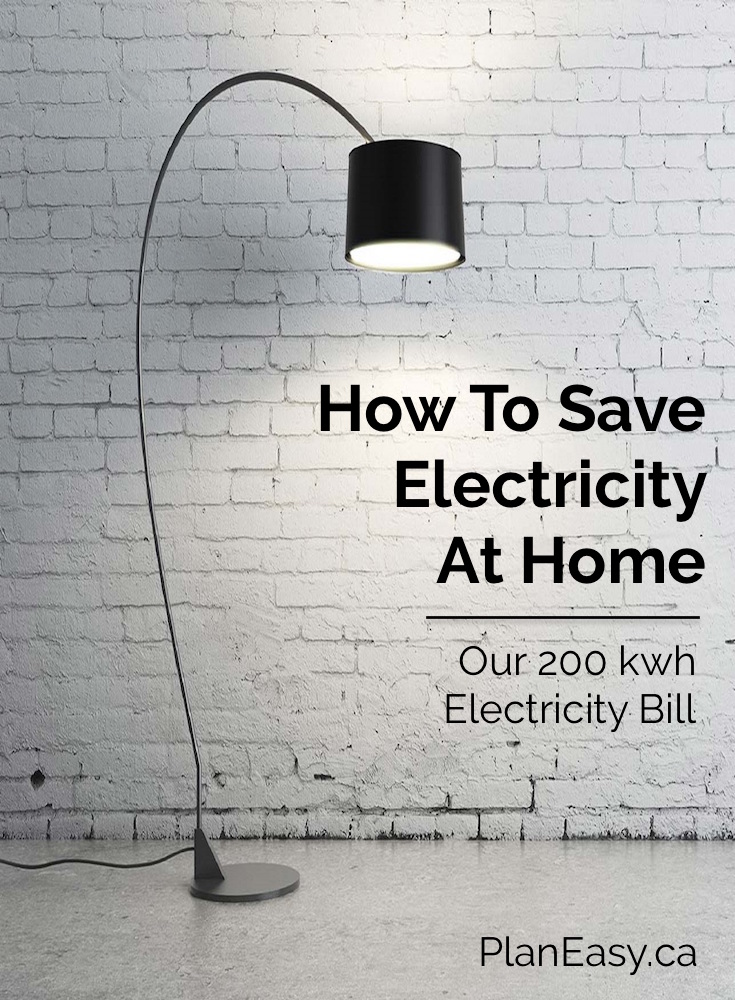How To Save Electricity At Home
(Our 200kwh Electricity Bill)
There are some things I hate to save money on. Things like entertainment, food, hobbies are at the very bottom of my savings list. These are the last things I’ll cut if I need to save money.
BUT on the flip side there are some things that I love to save money on. These are things that no one ever sees. These are things that no one ever cares about. It’s things like investment fees, car insurance, or utilities. No one cares how much you spend on that stuff, absolutely no one, so it’s the perfect way to save money.
If you can lower your electric bill by $20 per month, you’ll save an extra $240 per year and no one will have a clue.
When was the last time you compared electric bills? Never.
When was the last time you noticed the number of lights in a person’s home? Likely never.
Our electricity bill is down to around 200 kwh’s per month. At our present electricity rates, that’s about $50 per month for electricity. We’re not even that efficient. There are still things we can do to improve that number but it’s already about $30 lower than it was just last year. That money goes directly into savings each month.
Saving money on electricity is the perfect way to build stealth wealth. No one has a clue how much money you’re saving. Just put that money away and let it grow.
How do you go about lowering your electric bill? Here are three big points to consider…

Measure, Measure, Measure
What gets measured gets done. You can’t do anything about your electric bill until you start to measure your usage.
Getting that monthly bill tells you nothing.
To really lower your electric bill, you need more info. You need details by the hour or even by the minute. You need know which appliances are the biggest energy hogs in your home.
Below you’ll find more details about how to measure the electricity usage in your home. You’ll also find how much we use per month and a snapshot of our hourly usage.
Measure Your Entire Home…
Some hydro companies do this for free. London Hydro has an awesome online interface (screen shots below).
London Hydro tells you exactly how much electricity you use down to the hour. This is a great way to pin point those high usage appliances in your home. Appliances like the dryer, electric oven, pool pump, air conditioner or electric hot water heater all have high electricity usage. By breaking down electricity usage by the hour you’ll be able to see exactly how much these appliances are actually using.
Usage information like this can be eye opening. This can lead to changes in your behaviour and how you use these appliances.
Don’t get this info for free? No problem. There are new electricity monitors that can help you track your energy usage. Some of these devices even track energy usage to the minute or the second. Efergy has a range of home energy monitors to help track your home energy usage. (I have no affiliation with Efergy but I like their products).
These energy monitors are simple to install and usually pay for themselves in a few months. These monitors track the energy usage in your entire home. This is a great way to lower your electric bill.
Challenge yourself to lower your daily usage. Do things like turn off lights or hang-dry your clothes. Use the energy monitor to track your progress each day.
Our Hourly Electricity Usage

Our Monthly Electricity Usage

Measure Specific Appliances…
Another great resource for lowering your electric bills is your local library. Again, props to London Hydro because they offer the Kill-A-Watt meter through the London Library. You can borrow one of these devices for free!
Even if your local library doesn’t have a Kill-A-Watt meter available to borrow it’s still very affordable to purchase. Usually between $40-$60 a Kill-A-Watt meter can easily pay for itself in lower electric bills.
The Kill-A-Watt meter measures the electricity usage for any plug-in appliance in your home. Just plug any appliance into the Kill-A-Watt meter and then plug the meter into the wall.
Over a 24hr period the Kill-A-Watt meter will measure the energy usage for the appliance and give you an average usage. This is great for things like fridges that don’t run constantly. For example, a fridge doesn’t run 100% of the time but with the Kill-A-Watt meter you’re able to measure the average usage over a 24 hour period.
Have an extra “beer” fridge or chest freezer that’s only partially used? The Kill-A-Watt meter makes it very easy to see how much that extra appliance is costing you per day/week/month/year.
Measuring a specific appliance also lets you see how efficient it is compared to newer models. Sometimes it can make sense to upgrade your appliance just for the energy savings. Turns out that our fridge is fairly efficient with an average usage of just 52 watts per hour.
“What gets measured gets done. You can’t do anything about your electric bill until you start to measure your usage.”
Measure Vampire Power…
The Kill-A-Watt meter is also great for measuring vampire power.
Vampire power is the energy used by appliances even when they’re shut off. This is also called standby power.
The worst vampire appliance is usually home entertainment equipment. Things like PVRs, Cable Boxes, TVs etc.
Sometimes it can make sense to put these appliances on one power bar with an integrated timer. The timer will shut off the power to all these devices over night and during the day, periods when they’re usually not in use anyway.
Six Worst Appliances for Vampire Power

Understand Your Electricity Bill!
The last thing you need to do to lower your electric bill is to understand how you’re being charged.
Electric bills are misleading. Usually there is a variable portion, a delivery portion, a regulatory portion and then taxes.
In Ontario the variable portion is called time of use pricing (ToU). There are three different lines for low, medium and high cost usage.
Then there’s the delivery portion. This delivery portion sometimes makes up half your electric bill. It looks like a fixed charge but that’s not true! A portion of your delivery fee is also variable. Lowering your energy usage will help lower your delivery fee too!
In London there is another 2.5 cents per kwh associated to delivery and regulatory fees. These numbers are very hard to find. This variable rate should be included in the ToU pricing but it’s not. This makes it look like a fixed charge but you can lower this amount by lowering your electricity usage.
On top of delivery and regulatory fees you need to add the adjustment factor (about 3%) and taxes (now only 5% thanks to the 8% provincial tax rebate).
Only after making these adjustments will you get your real electricity rate. Your real electricity rate can be 25-40% higher than the ToU pricing suggests. This is what you can actually save by reducing your electricity consumption.
Start measuring and start saving!
Your Real Electricity Rate per KWH
(For London, Ontario. Your own rates may vary)
Join over 250,000 people reading PlanEasy.ca each year. New blog posts weekly!
Tax planning, benefit optimization, budgeting, family planning, retirement planning and more...
Join over 250,000 people reading PlanEasy.ca each year. New blog posts weekly!
Tax planning, benefit optimization, budgeting, family planning, retirement planning and more...






My electricity bill is quite high. I live alone, and my house is bordered on two sides by forests. So I’ll usually keep a few lights on around the house. Maybe I should just get a dog
Hi Troy, lights are usually not the biggest electricity user. Changing lights to CLF or LED can help. Wait for a sale or coupons. But otherwise it’s usually appliances like clothes dryer, water heater, pool pumps , acor electric stoves that is the most electricity.